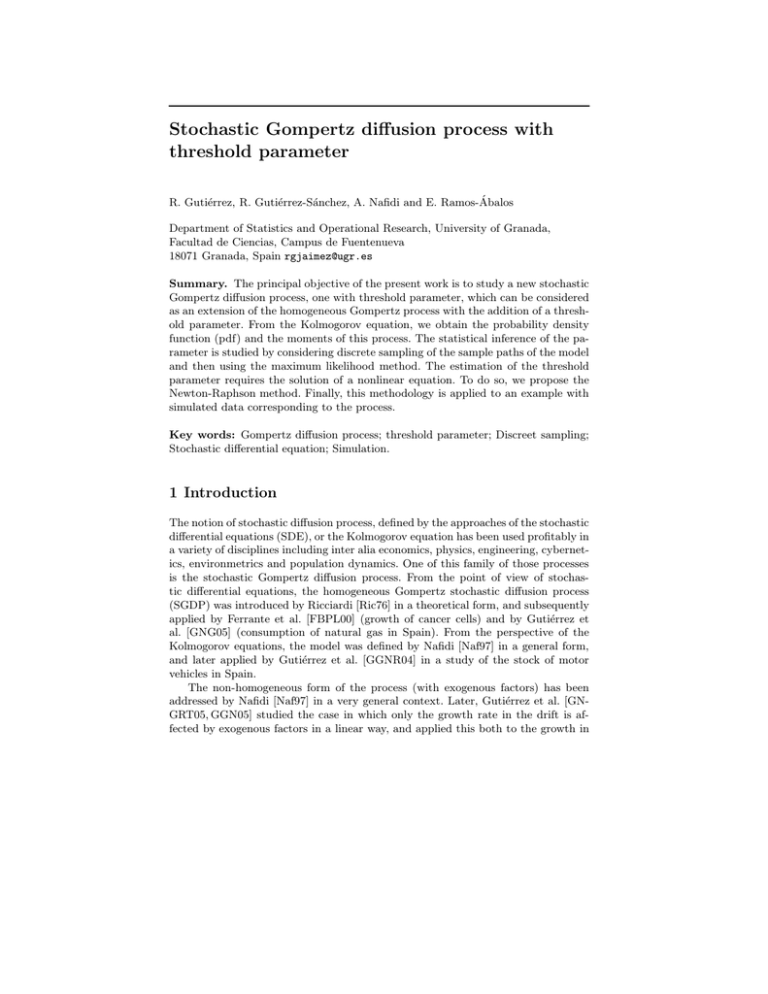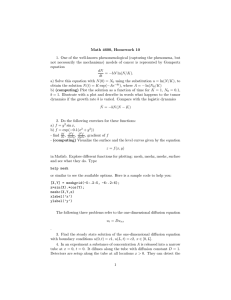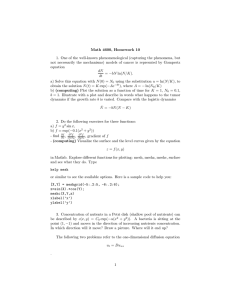Stochastic Gompertz diffusion process with threshold parameter
advertisement

Stochastic Gompertz diffusion process with
threshold parameter
R. Gutiérrez, R. Gutiérrez-Sánchez, A. Nafidi and E. Ramos-Ábalos
Department of Statistics and Operational Research, University of Granada,
Facultad de Ciencias, Campus de Fuentenueva
18071 Granada, Spain rgjaimez@ugr.es
Summary. The principal objective of the present work is to study a new stochastic
Gompertz diffusion process, one with threshold parameter, which can be considered
as an extension of the homogeneous Gompertz process with the addition of a threshold parameter. From the Kolmogorov equation, we obtain the probability density
function (pdf) and the moments of this process. The statistical inference of the parameter is studied by considering discrete sampling of the sample paths of the model
and then using the maximum likelihood method. The estimation of the threshold
parameter requires the solution of a nonlinear equation. To do so, we propose the
Newton-Raphson method. Finally, this methodology is applied to an example with
simulated data corresponding to the process.
Key words: Gompertz diffusion process; threshold parameter; Discreet sampling;
Stochastic differential equation; Simulation.
1 Introduction
The notion of stochastic diffusion process, defined by the approaches of the stochastic
differential equations (SDE), or the Kolmogorov equation has been used profitably in
a variety of disciplines including inter alia economics, physics, engineering, cybernetics, environmetrics and population dynamics. One of this family of those processes
is the stochastic Gompertz diffusion process. From the point of view of stochastic differential equations, the homogeneous Gompertz stochastic diffusion process
(SGDP) was introduced by Ricciardi [Ric76] in a theoretical form, and subsequently
applied by Ferrante et al. [FBPL00] (growth of cancer cells) and by Gutiérrez et
al. [GNG05] (consumption of natural gas in Spain). From the perspective of the
Kolmogorov equations, the model was defined by Nafidi [Naf97] in a general form,
and later applied by Gutiérrez et al. [GGNR04] in a study of the stock of motor
vehicles in Spain.
The non-homogeneous form of the process (with exogenous factors) has been
addressed by Nafidi [Naf97] in a very general context. Later, Gutiérrez et al. [GNGRT05, GGN05] studied the case in which only the growth rate in the drift is affected by exogenous factors in a linear way, and applied this both to the growth in
994
R. Gutiérrez, R. Gutiérrez-Sánchez, A. Nafidi and E. Ramos-Ábalos
the price of new housing in Spain and to the consumption of electricity in Morocco.
Finally, Ferrante et al. [FBPLM05] considered a non-homogeneous version in which
the growth rate is the sum of two exponential functions that are exogenous factors.
By analogy to lognormal diffusion process (see [Ram05] and Gutiérrez et.al
[GGR04]), we add a threshold parameter to the stochastic Gompertz diffusion process. This work is structured as follows: in the second section, we describe the model
using Kolmogorov equations and we calculate the p.d.f. and the moments of the
model. In the third section, we estimate the parameters of the model by the maximum likelihood method using discrete sampling. In order to estimate the new parameter, we obtain a nonlinear equation, which we propose to solve using Newton
Raphson method. In the fourth section, we simulate the trajectory of the process
from the exact solution of Itô’s SDE and we estimate the parameters.
2 The Model and its Basic Probabilistic Characteristics
2.1 The Model
The one-dimensional Gompertz diffusion process with threshold parameter can be
introduced by means of the Kolmogorov backward and forward equation as a Markov
process {Xt , t ∈ [t0 , T ]} with values in ]γ, +∞[, with almost-certainly continuous
trajectories and with a density function for the process transition (p.d.f) that is
given by f (y, t/x, s) = P[Xt = y | Xs = x] where x > γ, y > γ and γ ∈ R, and with
the infinitesimal moments
A(x) = α(x − γ) − β(x − γ) log(x − γ)
B(x) = σ 2 (x − γ)2
(1)
the corresponding Kolmogorov backward and forward equation are
∂f
∂[A(y)f ]
1 ∂ 2 [B(y)f ]
=−
+
∂t
∂y
2
∂y 2
∂f
∂f
1
∂2f
= −A(x)
− B(x) 2 .
∂s
∂x
2
∂x
Alternatively, the above-defined process can be considered as the solution of the
following Itô’s stochastic differential equation (SDE)
dXt = (Xt − γ) [α − β log(Xt − γ)] dt + σ(Xt − γ)dWt
Xt0 = x0
;
t ∈ [t0 , T ]
where W (t) is a standard Wiener process.
The common solution to the Kolmogorov equations can be obtained using Ricciardi’s theorem (see [Ric77]) of transformation diffusion process into Wiener process.
The infinitesimal moments (1) verify the conditions of the theorem cited, so such
transformation exists and have the following form
Stochastic Gompertz diffusion process with threshold parameter
α − σ 2 /2
βt
log(x − γ) −
σ
σ
̺(x, t) =
Z
t
ϕ(t) =
Z
t
995
eβτ dτ
e2βτ dτ.
(2)
The transition p.d.f. for the considered process, resulting
f (y, t | x, s) =
−1/2
[log(y − γ) − µ(s, t)]2
1 2πσ 2 λ2 (s, t)
exp −
y−γ
2σ 2 λ2 (s, t)
.
(3)
This transition is the density function of the one-dimensional lognormal
distribution Λ1 (µ(s, t), σ 2 λ2 (s, t)) with µ(s, t) and λ(s, t) are given respectively by
µ(s, t) = e−β(t−s) log(x − γ) +
1
λ2 (s, t) = 2β
(1 − e−2β(t−s) ).
α−σ 2 /2
(1
β
− e−β(t−s) )
2.2 The Moment of the Process
From (3) and by considering the initial distribution of the process, we obtain the
r th moment of the process. In particular, by assuming P [Xt0 = x0 ] = 1,
E(Xtr )
=
r
X
k=0
!
k2 2
r r−k
γ
exp kµ(t0 , t) +
λ (t0 , t)
2
k
from which the trend function (r = 1) is given by
E(Xt ) = γ + exp log(x0 − γ)e−β(t−t0 ) +
× exp
σ2 1 − e−2β(t−t0 )
.
4β
α − σ 2 /2 1 − e−β(t−t0 )
×
β
3 Estimation of the Parameters
Here, we give the estimation of drift parameters α, β and γ, and diffusion coefficient σ
by means of maximum likelihood method using discrete sampling. Let us consider a
discrete sample of the process (x1 , x2 , ..., xn ) at the instants of time (t1 , t2 , ..., tn ), and
let us assume, moreover, that the length of the time intervals [ti−1 , ti ] (i = 2, ..., n)
is equal to constant h (ti − ti−1 = h). Under the initial condition P[Xt1 = x1 ] = 1,
the associate likelihood function can be obtained by the following expression
L(x1 , ..., xn , a, β, σ 2 , γ) =
n
Y
f (xj , tj | xj−1 , tj−1 ) .
j=2
This function tends to infinity when γ tends to x(1) , where x(1) = inf 0≤j≤n (xj ).
996
R. Gutiérrez, R. Gutiérrez-Sánchez, A. Nafidi and E. Ramos-Ábalos
Using (3), the log-likelihood function can be written as follows
−β
−
"
log(xj − γ) − e
−βh
j=2
Log(L) =
−
n
X
a 1 − e−βh
log(xj−1 − γ) −
β
n−1
n−1
n−1
log(2π) −
log(σ 2 ) −
log
2
2
2
n
X
−
σ 2 (1 − e−2βh )
#2
−2βh
1−e
2β
log(xj − γ)
j=2
where a = α − σ 2 /2.
Differentiating the log-likelihood function with respect to the parameters and
after various operations (we dont show), we obtain the following equations
â =
n h
i
X
β̂
yj,γ̂ − e−β̂h yj−1,γ̂
(n − 1)(1 − e−β̂h ) j=2
"
n
X
2β̂
â
σ̂ =
yj,γ̂ − e−β̂h yj−1,γ̂ − (1 − e−β̂h )
−2
β̂h
(n − 1)(1 − e
) j=2
β̂
#2
2
0
"
n
X
B
B
1
B
β̂ = log B " n
B X
h
#2
− (n − 1)
yj,γ̂
j=2
#"
yj,γ̂
j=2
n
X
n
X
1
2
yj−1,γ̂
j=2
#
yj−1,γ̂ − (n − 1)
j=2
n
X
yj,γ̂ yj−1,γ̂
C
C
C
C
C
A
(4)
j=2
where yj,γ̂ = log(xj − γ̂) and yj−1,γ̂ = log(xj−1 − γ̂), for j=2,...,n.
The estimator of the threshold parameter γ is given by the following nonlinear
equation
n
X
j=2
"
"
#
X
2β̂
e−β̂h
1
1
+
−
×
2
−2
β̂h
xj − γ̂
xj−1 − γ̂
σ̂ (1 − e
) j=2 xj − γ̂
× log(xj − γ̂) − e
n
−β̂h
log(xj−1 − γ̂) −
â β̂
1−e
−β̂h
#
=0
where γ < x(1).
4 Simulation Studies
The trajectory of the model can be obtained by simulation of the exact solution
of the equation (2), this solution can be determinated by means of Itô’s formula
applied to the transform eβt log(Xt − γ), then we obtain the following equation
Stochastic Gompertz diffusion process with threshold parameter
h
997
i
d eβt log(Xt − γ) = (α − σ 2 /2)e−βt dt + σe−βt dWt .
By simplifying and integrating, the solution of the equation (2) leads us
Xt = γ + exp log(xs − γ)e−β(t−s) +
Z
t
× exp
e
−β(t−τ)
α − σ 2 /2 1 − e−β(t−s)
×
β
dWτ .
s
From this explicit solution, we can obtained the simulated trajectories of the process by discretising the time interval
[t0 , T ], and taking into account that the random
Rt
variable in the last expression s e−β(t−τ) dWτ is distributed as one-dimensional nor
Rt
mal distribution N1 0, s e−2β(t−τ) dτ .
From this simulated process sample, we estimate the parameters by maximum
likelihood using the Newton-Raphson nonlinear approach to approximate the value
of γ̂, then the parameters of the process are estimated by applying the method to the
simulated data set described previously, which enables us to test the effectiveness of
the method.
Table 1 shows the values used in the simulation and the results obtained by
estimating the parameters, using the methods described above, implemented using
the Mathematica packages by considering h = 1, n = 30 and an initial value x0 =
0.99.
Table 1. Values used in the simulation and estimation of the parameters
â
σ̂
β̂
γ̂
Simulation 1
0.0001
0.5
0.5
Estimation 0.999896 0.000130768 0.500062 0.500003
998
R. Gutiérrez, R. Gutiérrez-Sánchez, A. Nafidi and E. Ramos-Ábalos
Figure (4) shows ten simulated trajectories together with the theoretical trend
function of the process.
10
8
6
4
2
5
10
15
20
25
30
Fig. 1. Various simulated trajectories and the theoretical trend function
5 Conclusions
From a theoretical standpoint, the main conclusion to be drawn from the present
study is that it is possible to utilize a Gompertz homogeneous diffusion process that
contains a γ > 0 parameter in such a way that the process is defined in ]γ, ∞[, and
that this extends to the Gompertz process the idea of the existence of a ”threshold
parameter”, which has previously been considered both for probabilistic distributions
(for example, in the distributions of extreme values in reliability studies) and in other
diffusion processes such as the three-parameter lognormal distribution studied by the
present authors (see, for example [Ram05], [GGR04]).
The process presented in this paper can be studied probabilistically in an explicit
way, thus obtaining its transition probability density function and moment functions
(trend functions). From the statistical standpoint, we have shown that it is possible to establish an estimation method based on obtaining a conditional likelihood
function in a natural way, associated with the Markovian nature of the Gompertz
process being considered, this function being constructed from a discrete time sampling of the process. We can then derive the maximum likelihood estimators of the
four parameters for the model in question, including the threshold parameter. In
this respect, we have established a methodology for obtaining the estimators that
includes the numerical resolution of the implied nonlinear equation.
References
[FBPL00] Ferrante, L., Bompade, S., Possati, L., and Leone, L.: Parameter estimation in a Gompertzian stochastic model for tumor growth. Biometrics, 56,
1076–1081 (2000).
Stochastic Gompertz diffusion process with threshold parameter
999
[FBPLM05] Ferrante, L., Bompade, S., Possati, L., Leone, L., Montanari, M.P.:
A stochastic formulation of the Gompertzian growth model for in vitro
bactericidad kinetics: Parameter estimation and extinction probability.
Biomet. J. 47(3) 309–318 (2005).
[GGNR04] Gutiérrez, R., Gutiérrez, S.R., Nafidi, A., Ramos, E.: Studying the vehicle park in Spain by using the lognormal and Gompertz diffusion processes. In: Proceedings of SEIO’04, Spain: Cadiz; 171–172 (2004).
[GGR04] Gutiérrez, R., Gutiérrez, S.R., Ramos, E.: Inference in tri-parameter lognormal multidimensional diffusion processes with exogenous factors. In:
Robert Trappl (ed) Proceedings of the 17 European Meeting on Cybernetics and Systems Research, 1,157-162. Viena.
[GNG05] Gutiérrez, R., Nafidi, A., Gutiérrez, S.R.: Forecasting total natural gas
consumption in Spain by using the stochastic Gompertz innovation diffusion model. Appl. Energy, 80(2), 115–124 (2005).
[GNGRT05] Gutiérrez, R., Nafidi, A., Gutiérrez, S.R., Román, P., Torres, F.: Inference in Gompertz type non homogeneous stochastic systems by means of
discrete sampling. Cyber. and Syst. 36, 203–216 (2005).
[GGN05] Gutiérrez, R., Gutiérrez, S.R, Nafidi, A.: Electricity consumption in Morocco: Stochastic Gompertz diffusion analysis with exogenous factors.
Appl. Energy (2005) in press.
[Naf97] Nafidi, A.: Lognormal diffusion process with exogenous factors. Extensions
from the Gompertz diffusion process. MA Thesis Granada University,
”
Granada(1997).
[Ram05] Ramos, E.: Multidimensional three-parameter lognormal diffusions with
exogenous factors. MA Thesis Granada University, Granada(2005).
”
[Ric76]
Ricciardi, L. M.: On the transformation of difusion processes into the
Wiener processes. J. Math. Anal. and Appl. 54, 185–99 (1976).
[Ric77]
Ricciardi, L.M.: Diffusion process and related topic in biology. Lectures
Notes in Biomathematics 14, Springer Verlag (1977).






